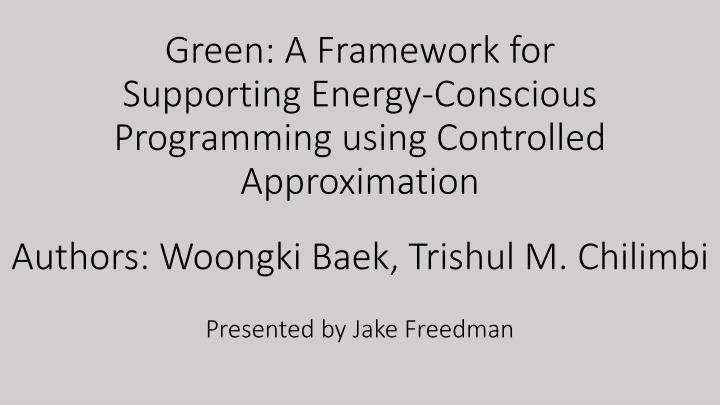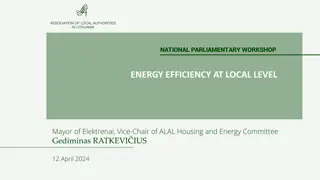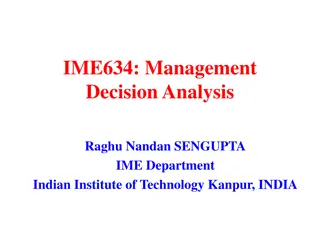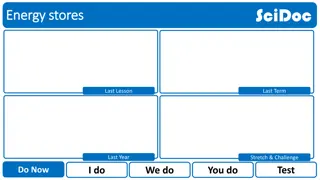Green: A Framework for Energy-Conscious Programming
Programmers often approximate functions and loops without quantifying the error or benefits, leading to maintenance challenges. The Green framework addresses this by quantifying tradeoffs in performance, energy consumption, and quality of service through a controlled approximation approach. It allows programmers to identify approximation targets and generates approximate programs at compile and runtime. By incorporating QoS computing and approximation functions, it provides a systematic way to manage approximation decisions effectively.
Download Presentation

Please find below an Image/Link to download the presentation.
The content on the website is provided AS IS for your information and personal use only. It may not be sold, licensed, or shared on other websites without obtaining consent from the author.If you encounter any issues during the download, it is possible that the publisher has removed the file from their server.
You are allowed to download the files provided on this website for personal or commercial use, subject to the condition that they are used lawfully. All files are the property of their respective owners.
The content on the website is provided AS IS for your information and personal use only. It may not be sold, licensed, or shared on other websites without obtaining consent from the author.
E N D
Presentation Transcript
Green: A Framework for Supporting Energy-Conscious Programming using Controlled Approximation Authors: Woongki Baek, Trishul M. Chilimbi Presented by Jake Freedman
Overview What problem is being solved? Programmers often approximate as-needed and heuristically without quantifying the error or benefits Why is that problem important? Programs that are approximated in an ad-hoc manner are hard to maintain as programs evolve, and understanding the effects of approximation is important How do the authors solve the problem? The Green framework uses a loss model based on approximations of functions, loops, and an error threshold to determine how and when to approximate a program while quantifying the tradeoffs in performance, energy consumption, and quality of service How is the approximation done? The approximated functions and approximation targets are provided and identified by the programmer, and the approximate program is generated at both compile time and runtime
QoS_Compute() Function must be provided by the programmer to calculate loss between approximated functions and precise functions Default loss computation is calculated by comparing precise values to approximated values This is used for simple computations and loop approximations Can become very complicated depending on the application Individual QoS_Compute() functions are integrated into one global function Works with the QoS target and approximations to construct the approximation model
QoS_Approx() Function determines if a loop or function should be approximated Loops Static approximation is determined in the calibration phase QoS_Approx() checks if breaking the loop at the current iteration would violate the target threshold, and if not, will terminate the loop Adaptive approximation periodically determines what the QoS improvement would be if the loop were to iterate one more time If the QoS improvement is greater than the target QoS improvement (referred to as delta), the loop will continue to iterate until the QoS improvement is less than the target delta For functions, QoS_Approx() determines if the function should be approximated and by which function
QoS_ReCalibrate() Implemented because the program behavior may differ from the training inputs, and the approximation can be recalibrated to either increase or decrease the loss For static loops, the number of iterations can either be increased to reduce loss or decreased to increase speed and decrease power consumption For adaptive loops, the target delta and period that the QoS improvement is measured can be changed Functions can be switched to more or less precise versions
Global Recalibration Because each function has its own QoS_Compute() function, local approximations can be changed in recalibration These changes are treated as independent When the loss is too great, the approximations are switched in an order that enables the greatest change in QoS while mitigating changes in performance If the effects of approximation are not independent or linear, the number of loop iterations are increased to a random number within a specific range, and functions are replaced with higher precision functions until the non-linear effects disappear The paper claims that this method quickly converges on an effective solution
Evaluation Green was tested on 5 different applications Measures of performance, energy consumption, and speed were recorded for each test All 5 tests are very different applications which shows the flexibility of the Green framework In each case, Green shows significant improvement in speed and power while maintaining reasonable loss
Bing search Bing takes a series of queries as arguments and searches an index of all available documents and returns the top N documents The documents are ranked according to how they match the queries The approximated version only searches a subset of the documents up to a maximum M, essentially using early loop termination The loss metric was defined by the percentage of queries that either return a different set of N documents or return N documents in a different order Because of the definition of the loss metric, custom loss and recalibration functions had to be written
252.eon 252.eon is a ray tracer used to include light in 3D renderings and video games The application can be approximated using early loop termination, as QoS improvements decrease over time Green was applied to 252 rendering a 3D model Performance was measured in terms of execution time QoS was calculated by comparing the approximated pixels to the precise pixels
Cluster GA Machine learning process to parallelize a program Runs and refines until it reaches a maximum QoS output The later refinements can be marginal improvements, so Green terminates the loop early Speed was measured in terms of execution time Loss was calculated by comparing the runtime of the output program from the precise CGA to the runtime of the output from the approximated CGA
Discrete Fourier Transform DFT uses sine and cosine functions that can be very expensive Sine and cosine can be approximated Loss was calculated by comparing the output sample of the precise and approximate program
Blacksholes Prices stock options using a partial differential equation Approximated by using exponential and logarithmic functions as a part of Taylor Series expansions Difference in output price between approximated and precise programs used to determine accuracy
Related Work Green is similar to several works including a paper we will read later in the semester: Probabilistic accuracy bounds for fault-tolerant computations that discard tasks The key takeaways that make this approach different are the Flexibility Less focus on fault tolerance More granular approximation Approximation of complex functions Level of control Safety
Multiple Choice 1. Green requires that the programmer provide A. Approximate functions B. Approximate loops C. An error threshold/QoS target D. A and C 2. If the QoS target is not met Green can A. Replace approximate functions with more precise versions B. Increase loop iterations C. Nothing can be done, and the program will fail D. A and B 3. Green requires A. A relatively large number of training inputs B. A relatively small number of training inputs























